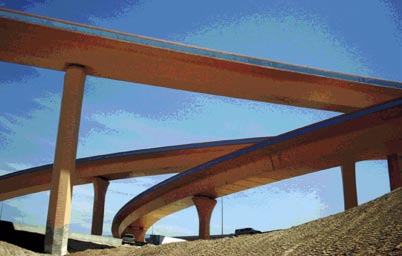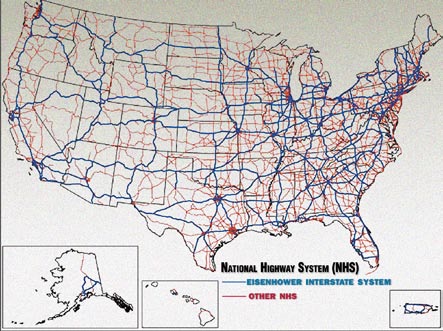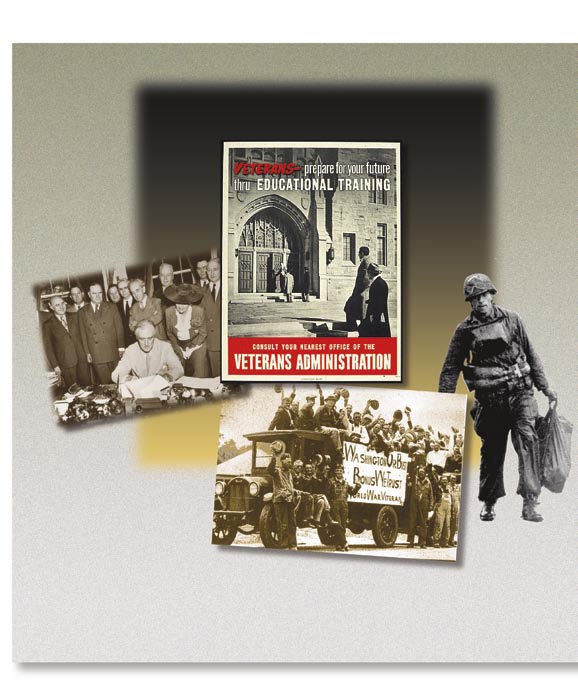“par,” which was the score that a professional golfer
The legislation was fortuitous. Following the war, the would achieve on a demanding golf course). In spite nation’s economy boomed, and everyone wanted a
of their considerable clout, not even leaders of the ATA
new car. Between 1945 and 1955, Americans more than
were capable of jump-starting the Interstate Highway
doubled the number of automobiles and trucks on the na-
System.
tion’s streets. In urban areas such as New York, Chicago,
Los Angeles, Dallas, Miami, and Houston, traffic jams,
delays, and accidents spiraled upward. In 1950, the U.S.
President Eisenhower
Chamber of Commerce reported that 40 percent of trip
time in New England cities was wasted in traffic jams.
and the Clay Committee
As traffic delays grew worse, downtown retailers contin-
ued to worry about lost sales to new competitors who
were opening stores in fast-growing suburbs. In spite
President Dwight D. Eisenhower, who
of the Federal-Aid Highway Act, rapid
assumed office in 1953, also failed to
increases in the costs of labor and materi-
break the deadlock over who would pay
als reduced the number of miles actually
the cost of building the IHS. Like his
constructed. Equally important, truck and
contemporaries, Eisenhower wanted to
auto manufacturers built – and Americans
reduce traffic jams, and in principle he sup-
purchased – vehicles that were heavier,
ported the idea of a new highway system.
faster, and longer. If road engineers such
Construction of the IHS over a long period
as MacDonald were to construct a new
of time, Eisenhower and his economic ad-
generation of roads that were safe and ef-
visers believed, would help stimulate the
ficient, then those roads would also have to
U.S. economy. At the same time, however,
be wider, thicker, and far costlier to build
Eisenhower did not want a highway fund-
and maintain. MacDonald estimated that
ing program that would place too great a
the pressure of traffic on the nation’s roads
financial burden on the federal budget.
was eight times greater than in the decades
In August 1954, Eisenhower asked for-
before World War II. As in previous years,
mer U.S. Army General Lucius D. Clay to
leaders of farm, truck, and urban groups
Dwight D. Eisenhower, the likeable ex-
head a committee that would recommend
remained deadlocked over who should pay general who was president for most of the some way of financing an Interstate High-1950s, presided over the creation of the
for these new roads and where they should
Interstate Highway System.
way System. In January 1955, Clay recom-
be located.
mended issuance by the U.S. government
Starting in 1951, leaders of the influential trucking
of $25 billion in bonds that would be retired over 30
industry attempted to break the deadlock in highway
years with funds derived from the federal tax on gasoline
politics. In this period, most trucking firms were small,
and occasional borrowing from the U.S. Treasury. Bond
employing only a few office personnel and fewer than 100
sales to corporations, governments, and private individu-
drivers. The key to truckers’ clout in American politics
als, Clay reasoned, would finance most of the costs of
was their trade association. Headquartered in Washing-
building the IHS without adding to the federal budget
ton, D.C., and with members in every state, the American
or the national debt. Bowing to political reality, Clay pro-
Trucking Associations (ATA) employed talented attor-
posed that the federal government would pay 90 percent
neys who were expert at defending truckers’ interests in
of the costs associated with building the IHS and state
courts and at bringing the concerns of member truckers to
governments would pay 10 percent. Up to that point, the
the offices of senators, representatives, and to the White
federal and state governments had continued to split the
House. Complaining of traffic delays, truck operators still
costs of highway building on a 50-50 basis.
wanted the federal government to spend less money on
Immediately, Clay’s plan was attacked by the same in-
little used rural roads and more money on key routes in
terest groups. Leaders of farm groups objected to Clay’s
and through major cities. During the period 1951-1953,
plan to freeze spending on local farm roads for a period of
they began a lobbying campaign called PAR, which stood
30 years while the bonds were paid off. Equally
for Project Adequate Roads. (Excellent at adapting their
important, the powerful Senator Harry F. Byrd of
42


Virginia did not want the federal government to have to
name of the IHS to the National System of Interstate
pay interest on such a large bond issue.
and Defense Highways. Ordinary Americans have
As an alternative to Clay’s ideas, Representative
called it simply the Interstate Highway System.
George H. Fallon of Maryland prepared legislation that
Finally, in 1956 Congress and the president formally
would have paid directly for highway construction out of
conferred authority on engineers in the U.S. Bureau of
the U.S. federal budget. Fallon’s bill, however, re-
Public Roads and their counterparts in the state high-
quired a vast increase in gasoline and tire taxes. In July
way departments to start the new system by building
1955, nearly 500 truckers went to the nation’s capital to
41,000 miles, including approximately 5,000 urban miles.
complain to senators and representatives about Fallon’s
True to the promise of IHS enthusiasts, by the late
proposal for higher taxes. On July 27, members of the
1980s, the compact IHS carried more than 20 percent
House of Representatives voted to reject both Clay’s
of the nation’s automobile traffic and a whopping 49
proposals and the substitute offered by Fallon. Although
percent of the truck-trailer combinations. In the follow-
the extremely popular President Eisenhower had nar-
ing decades, Congress approved additional mileage for
rowed the range of debate about highway funding, in
the IHS, and by 2002 the rural and urban components
this instance he could not translate that popularity into
of the total system stood at 47,742 miles. By early 2004,
a formula that satisfied the many
the federal government had spent
competitors for highway-construc-
more than $59 billion to construct
tion dollars.
urban portions of the IHS and
more than $40 billion to construct
Solution
the rural sections.
to Deadlock:
Protests and More
a Highway Trust
Local Control
Fund
The construction of a vast new
highway system affected the
lives of millions of people. While
In 1956, Senator Albert Gore
many welcomed the new roads,
Sr., of Tennessee and Repre-
others disliked them as symbols of
sentative Hale Boggs of Louisiana
runaway modernity that chewed
joined with Representative Fallon
up landscape and/or urban areas.
to make yet another attempt to
Protests against highway build-
pass IHS legislation. The key to
ing led Congress to shift control
their success was in providing a
of highway construction away
little something for all interests:
Some say the IHS vastly improved America; others believe it from state and federal engineers.
more spending for rural, urban, and led to more suburban sprawl, ugliness, and traffic congestion As early as 1959, residents and interstate highways, but all this
– as here at a bad moment on Interstate 95 near Washington,
political leaders in San Fran-
accomplished with only a small in- D.C. Liked or disliked, the system defined American modernity. cisco blocked construction of the crease in gasoline and other automotive and truck taxes.
Embarcadero Freeway. Starting in 1962, residents of
As part of this arrangement, Congress and Eisenhower
Baltimore banded together to protect city neighborhoods
approved creation of the Highway Trust Fund, which
from destruction by highway engineers. In the late 1960s
would designate gasoline taxes (and excise taxes on tires
and early 1970s, upper-income residents of Northwest
and trucks) for exclusive use in financing construction
Washington, D.C., made use of political savvy and legal
of the IHS and other federal-aid roads. No longer would
know-how to block construction of the Three Sisters
truck operators complain about gasoline taxes used for
Bridge across the Potomac River. Authors of books with
non-highway purposes. To build public support for the
titles such as The Pavers and the Paved and Superhighway-
final agreement, early in 1956 members of the Senate-
Superhoax attracted national attention to this “freeway
House conference committee officially changed the
revolt” taking place.
43








In response to this resistance at the local level, in 1973,
The construction of the Interstate Highway System
Congress and President Richard M. Nixon approved the
produced important consequences in the American
Federal-Aid Highway Act, which fi nanced local purchase
future. The vast new ribbons of concrete helped speed
of buses and fi xed rail systems with money taken from
up the process whereby millions of Americans moved
the formerly inviolable Highway Trust Fund. In 1991,
from central cities to suburbs. By 1970, the United
Congress and President George H.W. Bush approved
States was already a “suburban nation.” Equally impor-
the Intermodal Surface Transportation Effi ciency Act
tant, the system (along with the postwar development
(ISTEA). Now, local political leaders in metropolitan
of television, public schools, and the existing network
planning organizations could have a say in choosing
of roads) was catalytic in knitting together the economic
whether to spend a portion of federal and state funds on
and social outlooks of more than 290 million persons.
highways, public transit, bike paths, or other projects.
Accents, diets, and customs became less regional, more
Passage of ISTEA comprised an important element in
national. Nearly as important, construction of the IHS
the devolution of federal highway funds and authority
permitted truck operators to displace the nation’s
from national and state engineering experts to local politi-
railroads in competition for prompt delivery of food,
cians.
furniture, refrigerators, and everything else.
Whether under construction (above) or
complete (inset), superhighways now
carry Americans ceaselessly day and
night, on business or pleasure.
44



While railroads still maintained their own trackbeds,
social cohesion, and the reorientation of politics and
in effect the government had fi nanced truckers’ right-
public policy in the United States.
of-way. In terms of political consequences, after 1970
the federal highway program was devolved to the states
Mark H. Rose is a professor of history at Florida Atlantic University. He is and localities, setting a pattern for similar attempts in
the author of more than 30 articles and several books, including: The Best areas such as social welfare spending. To this day, the
Transportation System in the World: Railroads, Trucks, Airlines, and
Interstate Highway System remains the nation’s greatest
American Public Policy in the Twentieth Century , with Bruce E. Seely
public works project. It was a successful intersection
and Paul Barrett. Rose is also co-editor of Business, Politics, and Society , a between politics and commerce; an experiment that had
book series published by the University of Pennsylvania Press.
notable consequences for transportation, urban change,
In this map, the Interstate highway system is limned in blue, showing how it linked the nation.
45


When the “Bonus Boys” – demobilized soldiers
of World War I – seen here in a crowded
truck, converged on Washington in 1932, they
were suppressed by the army.
World War II vets, in contrast, were offered
mass access to higher education through
the “GI Bill,” signed in 1944 by President
Franklin D. Roosevelt. Education of
returning troops saved a generation and put
America on the road to the boom
of the ‘50s.
46




by Milton Greenberg
The
GI Bill of Rights
THE GI BILL OF RIGHTS, OFFICIALLY KNOWN AS THE
SERVICEMEN’S READJUSTMENT ACT OF 1944, WAS SIGNED
INTO LAW ON JUNE 22, 1944, BY PRESIDENT FRANKLIN D.
ROOSEVELT. AT THE TIME, ITS PASSAGE THROUGH
CONGRESS WAS LARGELY UNHERALDED, IN PART BECAUSE
THE NORMANDY INVASION WAS UNDER WAY; BUT ALSO
BECAUSE ITS FUNDAMENTAL SIGNIFICANCE AND MAJOR
CONSEQUENCES FOR AMERICAN SOCIETY COULD NOT HAVE
BEEN FORESEEN. HOWEVER, WITH THE END OF THE WAR
IN BOTH EUROPE AND ASIA JUST A YEAR LATER, THE GI
BILL’S PROVISIONS WOULD SOON BE QUICKLY AND
FULLY TESTED. WITHIN A FEW YEARS, THE NEW LAW SERVED
TO CHANGE THE SOCIAL AND ECONOMIC LANDSCAPE OF
THE UNITED STATES.
47


Among its provisions, the law made available to World of World War I, exacerbated by deteriorating economic War II veterans immediate financial support in the
conditions, had led to protest marches and disastrous
form of unemployment insurance. Far more important,
confrontations. In 1932, 20,000 veterans gathered in
as it turned out, were generous educational opportunities
Washington, D.C., for a “bonus march,” hoping to obtain
ranging from vocational and on-the-job training to higher
financial rewards they thought they had been promised
education, and liberal access to loans for a home or a busi-
for service in World War I, leading to one of America’s
ness.
most tragic moments. Altercations led President
While there were numerous bills introduced in Con-
Hoover to call out the army, which under the leadership
gress to reward the combat-weary veterans of World War
of future military heroes General Douglas MacArthur
II, this particular bill had a significant sponsor. The
and Majors Dwight Eisenhower and George Patton used
major force behind the Servicemen’s Readjustment Act
guns and tanks against the “bonus army.”
of 1944 was the well-known American Legion, a private
In the minds of Washington policymakers who had
veterans advocacy group founded in 1919. The Legion,
witnessed this confrontation, the viable legislation to
during its 25th annual convention in September 1943,
meet the needs of veterans that emerged in 1944 came
initiated its own cam-
not a moment too soon.
paign for comprehensive
Even when it was clear
support of veterans. It
that the Allies were going
labeled the resulting
to win, few foresaw the
ideas, crafted into one
complete capitulation of
legislative proposal by
the Axis powers one year
the Legion’s national
later with the dropping of
commander Harry W.
the atomic bomb on Hiro-
Colmery, “a bill of rights
shima and Nagasaki, and
for GI Joe and GI Jane,”
the sudden return of more
but the proposal soon
than 15 million veterans
became known as the GI
of the Army, the Navy,
Bill of Rights. The term
and the Marine Corps,
GI – the slang term for
streaming home from
American soldiers in that
the Atlantic and Pacific
war – originally stood
theaters.
for “Government Is-
We must remember
sue,” referring to military
that for 12 years prior to
regulations or equipment.
the Japanese bombing
Wedded to the idea of
attack on the U.S. naval
the “Bill of Rights” in the
base in Pearl Harbor,
revered U.S. Constitution,
Hawaii – the attack that
the “GI Bill” was bound
drew America into World
to project an appealing
War II – America was in
These were the lucky ones – men who survived World War II –
aura in the halls of Con-
returning home from Europe on a troop ship in 1945. The GI Bill would make it a deep economic depres-gress as politicians sought
easier for them to rejoin civilian life.
sion. Thus, the war,
ways to reward the homebound soldiers.
when it came, found the nation unprepared and largely
But there is more to the story. Though it might appear
uneducated, faced with the need to build a fighting force
that the adoption and passage of the bill was entirely the
of young people who had known only the Great Depres-
result of unbridled generosity on the part of a grateful
sion years. Unemployment was widespread, with 25
Congress, it was also in large measure a product of justi-
percent of the workforce unemployed at the height of
fied concern, even a certain fear, on the part of lawmak-
the depression in 1933. Breadlines and soup kitchens
ers about a radicalized postwar America. Prior to World
for even formerly prosperous middle-class men personi-
War II, America had provided benefits and care to those
fied the era, and entire families thought they faced a life
disabled by combat, but had paid little attention to its
of poverty and joblessness. Most of the industrialized
able-bodied veterans. Within living memory of many
world in one way or another was caught up in the same
public men of the time, neglect of the returning veterans
calamity, with disastrous political results, including the
48

rise of totalitarian regimes in crisis-ridden nations around
basis to blacks and whites. In the mid-1940s, $20 was a
the world.
lot of money. For 15 cents or even less, one could buy
Though the New Deal government of President
gasoline, cigarettes, beer, milk shakes, or go to a movie.
Franklin D. Roosevelt, first elected in 1932, initiated
Yet – and this is indicative of that generation’s response
numerous governmental programs that generated some
to the war’s end, and the stigma in those days that came
employment, 10 million people, or about 17 percent of
with accepting public money – only slightly more than
the workforce, were still unemployed in 1939. The out-
half the veterans even claimed the money; and most
break of the war in Europe in 1939 brought forth a new
used it for so few weeks that less than 20 percent of the
surge of economic activity as well as an ensuing military
estimated cost was actually spent.
draft. Ironically, it was the American entry into the war
For educational benefits, the method was for the
in late 1941 that put an end to the Great Depression, by
Veterans Administration (VA) to certify eligibility, pay
taking young men temporarily out of circulation as most
the bills to the school for tuition, fees, and books, and
went into the military and putting everyone else to work
to mail a monthly living stipend to the veteran for up
on the home front, including large numbers of women.
to 48 months of schooling, depending upon length of
The American Legion, strongly supported by William
service. For home loans for GIs, the VA guaranteed a
Randolph Hearst and his chain of newspapers, waged
sizeable portion of the loan to the lending institution
their campaign for the GI Bill by stressing fear of a return
and mortgage rates were set at a low 4 percent interest.
to prewar breadlines and resulting threats to democracy.
The formal aspects of these programs have lived on in
subsequent, though less generous, versions of the GI
Bill for Korean War and Vietnam War veterans – and still
Same Rules for All
continue as an enlistment incentive for America’s cur-
rent volunteer military under what is now known as the
In spirit, as well as specific provisions, the GI Bill was Montgomery GI Bill.

























